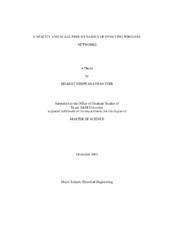| dc.description.abstract | Many large-scale random graphs (e.g., the Internet) exhibit complex topology, nonhomogeneous spatial node distribution, and preferential attachment of new nodes. Current topology models for ad-hoc networks mostly consider a uniform spatial distribution of nodes and do not capture the dynamics of evolving, real-world graphs, in which nodes "gravitate" toward popular locations and self-organize into non-uniform clusters. In this thesis, we first investigate two constraints on scalability of ad-hoc networks – network reliability and node capacity. Unlike other studies, we analyze network resilience to node and link failure with an emphasis on the growth (i.e., evolution) dynamics of the entire system. Along the way, we also study important graph-theoretic properties of ad-hoc networks (including the clustering coefficient and the expected path length) and strengthen our generic understanding of these systems. Finally, recognizing that under existing uniform models future ad-hoc networks cannot scale beyond trivial sizes, we argue that ad-hoc networks should be modeled from an evolution standpoint, which takes into account the well-known "clustering" phenomena observed in all real-world graphs. This model is likely to describe how future ad-hoc networks will self-organize since it is well documented that information content distribution among end-users (as well as among spatial locations) is non-uniform (often heavy-tailed). Results show that node capacity in the proposed evolution model scales to larger network sizes than in traditional approaches, which suggest that non-uniformly clustered, self-organizing, very large-scale ad-hoc networks may become feasible in the future. | en |


